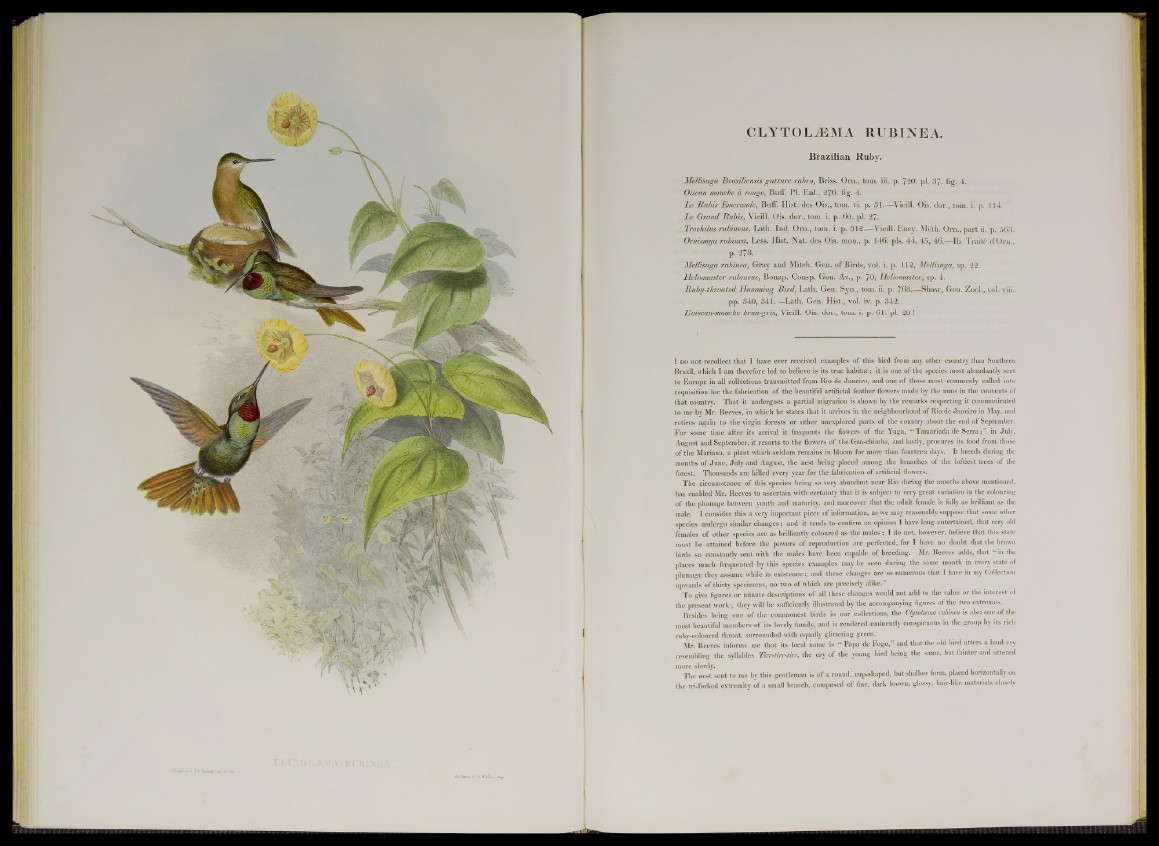
CLYTOLÆMA RUBINEA.
Brazilian Ruby.
Mellisuga Brasïliensis g u ttu re rubro, Briss. O rn ., tom. iii. p. 720. pl. 37- fig. 4.
Oiseau mouche à rouge, Buff. P l. E n l., 276. fig. 4.
L e Ru b is Emeraude, Buff. Hist, des Ois., tom. vi. p. 31.—Vieill. Ois. dor., tom. i. p. 114.
L e Grand Rubis, Vieill. Ois. dor., tom. i. p. 60. pl. 27.
Trochilus rubineus, Lath. Ind. Orn ., tom. i. p. 312.-—Vieill. Ency. Méth. Orn., p a rt ii. p. 563.
Ornismya rubinea, Less. Hist. N at. des Ois. mou., p. 146. pis. 44, 45, 46.—Ib . Tra ité d’Orn.,
p. 278.
Mellisuga rubinea, Gray and Mitch. Gen. o f Birds, vol. i. p. 112, Mellisuga, sp. 22.
Heliomaster rubineus, Bonap. Consp. Geu. Av., p. 70, Heliomaster, sp. 4.
Ru b y -th ro a ted Humming B ird , Lath. Gen. Syn., tom. ii. p. 768.— Shaw, Gen. Zool., vol. viii.
pp. 340, 341.—Lath. Gen. Hist., vol. iv. p. 342.
E oiseau-mouche brun-gris, Vieill. Ois. dor., tom. i. p. 61. pi. 28?
I d o not recollect that I have ever received examples of this bird from any other country than Southern
Brazil, which I am therefore led to believe is its true habitat; it is one of the species most abundantly sent
to Europe in all collections transmitted from Rio de Janeiro, and one of those most commonly called into
requisition for the fabrication of the beautiful artificial feather flowers made by the nuns in the convents of
that country. That it undergoes a partial migration is shown by the remarks respecting it communicated
to me by Mr. Reeves, in which he states that it arrives in the neighbourhood of Rio de Janeiro in May, and
retires again to the virgin forests or other unexplored parts of the country about the end of September.
For some time after its arrival it frequents the flowers of the Yuga, “ Tamarinda de S e rra ;” in July,
August and September, it resorts to the flowers of the Gua-chimba, and lastly, procures its food from those
of the Mariana, a plant which seldom remains in bloom for more than fourteen days. It breeds during the
months of June, July and August, the nest being placed among the branches of the loftiest trees of the
forest. Thousands are killed every year for the fabrication of artificial flowers.
The circumstance of this species being so very abundant near Rio during the months above mentioned,
has enabled Mr. Reeves to ascertain with certainty that it is subject to very great variation in the colouring
of the plumage between youth and maturity, and moreover that the adult female is fully as brilliant as the
male. I consider this a very important piece of information, as we may reasonably suppose that some other
species undergo similar changes; and it tends to confirm an opinion I have long entertained, that very old
females of other species are as brilliantly coloured as the males ; I do not, however, believe that this state
must be attained before the powers of reproduction are perfected, for I have no doubt that the brown
birds so constantly sent with the males have been capable of breeding. Mr. Reeves adds, that “ in the
places much frequented by this species examples may be seen during the same month in every state of
plumage they assume while in existence ; and these changes are so numerous that I have in my Collection
upwards of thirty specimens, no two of which are precisely alike.”
To give figures or minute descriptions of all these changes would not add to the value or the interest of
the present work; they will be sufficiently illustrated by the accompanying figures of the two extremes.
Besides being one of the commonest birds in our collections, the Clytolcema rubinea is also one of the
most beautiful members of its lovely family, and is rendered eminently conspicuous in the group by its rich
ruby-coloured throat, surrounded with equally glittering green.
Mr. Reeves informs me that its local name is “ Papa de Fogo,” and that the old bird utters a loud cry
resembling the syllables Tirr-tirr-tirr, the cry of the young bird being the same, but fainter and uttered
more slowly.
The nest sent to me by this gentleman is of a round, cup-shaped, but shallow form, placed horizontally on
the tri-forked extremity of a small branch, composed of fine, dark brown, glossy, hair-like materials closely